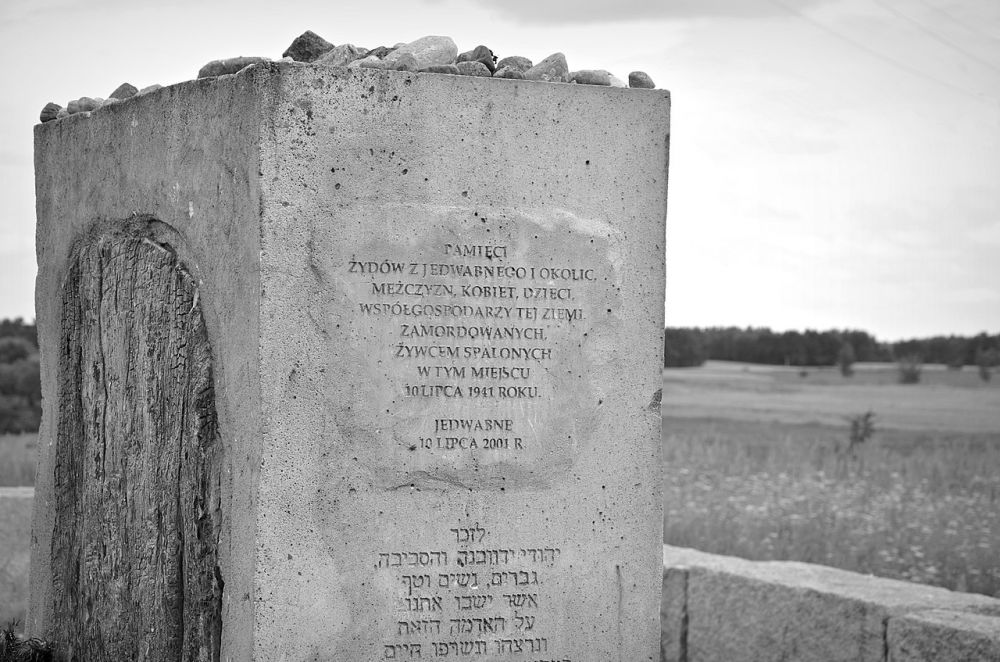- News
- Events
- Oneg Shabbat
- Collections
- Research
- Exhibitions
- Education
- Publishing Department
- Genealogy
- About the Institute
- Bookstore


Monument-grave at the cemetery in Jedwabne. Photo by Fotonews, Wikipedia, CC BY-SA 3.0.
On 10 July 1941 in the town of Jedwabne, the most cruel – according to contemporary knowledge — of anti-Jewish pogroms known to the public opinion and to historians, and carried out by Polish hands, took place.
On 10 July 1941, several weeks after the German army captured the Białystok region and a week or two after the establishment of local governments in the area, Jewish inhabitants of Jedwabne (along with refugees from other locations) were submitted to hours of torture, gathered in a barn and burned alive by their neighbours and peasants from nearby villages.
People who were discovered hiding, included small children, were thrown into glowing coal. Only a small number of people managed to escape. The number of victims – according to various estimates, with an assumption, that nearly all the Jews who were present in town were killed – varies between 900 and 1600 people. The latter number corresponds with a rough estimate of the size of the entire Jewish community in Jedwabne before September 1939. It is very likely that it had changed within the next two years. Partial exhumation in June 2001 has revealed the existence of two graves of murder victims, where – according to assessors – 300-400 people (adult men and women, children and the elderly) and 35-40 people were buried respectively. It is likely that there also exist additional graves of the Jews from Jedwabne who had died due to individual acts of violence, and perhaps further mass graves.
In the genesis of the pogrom, a large emphasis has been put on the motive of revenge on the Jews on the period of Soviet occupation, especially for denouncing a unit of anti-Soviet partisans in 1940 (after the war it was revealed that the informers were actually Polish). But acts of hostility against the Jews in this part of Poland were happening already before World War II, which could be partly attributed to some inhabitants’ support for National Democracy. The role of Germans in the events wasn’t fully explained; were they an initiative of Jedwabne’s inhabitants; what was the scope of inspiration and permission from the occupation authorities; did the occupant army take part in the pogrom, and if so, to which extent.
Tragic events in Jedwabne were not the only pogrom of Jewish people in this part of the Białystok region. Even earlier, on 25 June 1941, anti-Jewish violence took place in Jedwabne, with fatal casualties. Later, in the region roughly identical with former Wizna Land, a series of increasingly violent pogroms took place, including Wąsocz Grajewski and Radziłów, where several hundred Jews were killed. Jedwabne was the culmination of this wave.
On 16 and 17 May 1949, after a short investigation carried out by the Public Security Office, a court trial of people accused of participating in the Jedwabne pogrom took place in Łomża. 21 people had been charged, 11 of them were sentenced to 8–15 years in prison, one person received a death sentence.
The first information about the Jedwabne pogrom was published in 1966 by Szymon Datner in an article published in the „JHI Bulletin”. In 1967, the Regional Commission for Research of Nazi Crimes in Białystok began another investigation in the case. Yet only in 2000 the events became recognized by wider public opinion and discussed, mostly thanks to Jan Tomasz Gross’ book Neighbors: The Destruction of the Jewish Community in Jedwabne, Poland (deservedly criticized for not following academic standards in many places, although this doesn’t change its moral significance for the Polish side) and press publications (in 1999, Polish Television broadcast Agnieszka Arnold’s documentary dedicated to events related to the pogrom). In Summer 2000, the National Remembrance Institute initiated third investigation about the pogrom. Initial results, announced on 10 July 2002, have confirmed that the murder was carried out by Poles, group of whom was estimated for about 40 people. Germans have played a certain role in the first phase of the pogrom – gathering the Jews on the town square and abusing them. In the second phase – gathering the people in the barn and burning them alive – the Germans could have been only observing the events.
The case of the Jedwabne pogrom has led to an intensive polemic in the Polish press. The judgements were not unequivocal. It was seen as an example of putting the history straight and a beginning of an examination of the nation’s conscience. Yet it has also revealed the strength of anti-Semitic attitudes emerging as attacks on „anti-Polonism”, publications (including books) about the „Jedwabne lie”, in an increase of antipathy towards Jews and even, in certain circles, a feeling of an imaginary Jewish threat. The content of an inscription on the monument revealed on the 60th anniversary of the tragic events in the presence of the President of Poland Aleksander Kwaśniewski remains a subject of discussion, because the perpetrators of the crime were not mentioned.